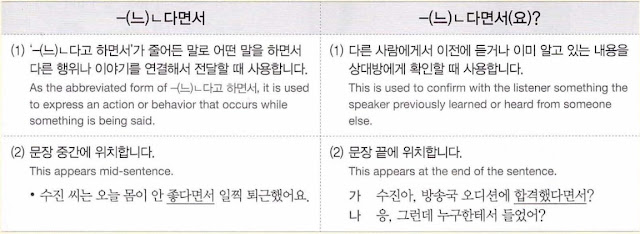가: 요즘 투안 씨가 무슨 일이 있나 봐요. 수업이 끝나자마자 늦었다면서 뛰어나가던데요.
가: It seems that something’s happened to Tuan recently. As soon as class ended, he ran off while saying he was late.
나: 지난주부터 학교 앞 갈빗집에서 아르바이트한대요.
나: He said he started a part-time job at the ribs restaurant near the school from last week.
가: 그래요? 얼마 전에 돈이 없다면서 아르바이트를 해야 겠다고 하더니 결국 일자리를 찾았군요.
가: Really? A while ago, he had said he was out of money and had to get a job, so I guess he finally found a place to work.
나: 네, 투안 씨 일하는 식당에 가면 투안 씨가 많이 먹으라면서 이것저것 더 갖다 주더 라고요.
나: Yeah, when I went to the restaurant where Tuan works, he gave us all kinds of extra things while telling us to eat up.
This expression is the abbreviated form of -(느)ㄴ다고 하면서 and is used to convey the doing of some action while saying something or the connecting of one statement to a previously mentioned statement. The form -(느)ㄴ다며 can also be used. ★ 형용사의 의문형은 ‘으냐면서’와 ‘-냐면서’ 둘 다 가능하고 동사의 의문형은 ‘느냐면서’와 ‘-냐면서’ 둘 다 모두 가능합니다.
★ 형용사의 의문형은 ‘으냐면서’와 ‘-냐면서’ 둘 다 가능하고 동사의 의문형은 ‘느냐면서’와 ‘-냐면서’ 둘 다 모두 가능합니다.
• 어떤 남자가 선호 씨를 찾는다면서 사무실을 기웃거 렸다.
Some guy came looking around the office saying he was looking for Sunho.
• 동주 씨는 요즘 건강이 나빠졌다면서 운동을 해야겠다고 하더군요.
Noting how his health had gotten worse recently, Dongju said he had to exercise.
• 사장님은 신제품의 판매가 왜 이렇게 저조하냐며 새로운 판매 전략을 생각해 보라고 하셨다.
The company president, asking why sales figures of the new product were so poor, told us to think of some new sales strategies.
This expression requires the subjects of the preceding and following clauses to be the same. Moreover, the subject should only appear once in the preceding clause.
• 윤호 씨는 복사기에 종이가 또 걸렸다면서 수진 씨가 짜증을 냈다. (X)
-> 윤호 씨는 복사기에 종이가 또 걸렸다면서 (윤호 씨가) 짜증을 냈다. (〇)
• 수진 씨는 부장님께 결재를 받으러 간다면서 수진 씨는 5층으로 을라갔다. (X)
-> 수진 씨는 부장님께 결재를 받으러 간다면서 5층으로 을라갔다. (〇)
이 표현은 중급에서 배운 ‘_(느)느 다면서(요)?’와 형태는 같지만 의미와 쓰임에는 다음과 같은 차이가 있습니다.
While this expression is identical in form to -(느)ㄴ다면서(요)? which we learned in the intermediate level, its meaning and usage differ as follows.
>> You can click on the title of each grammar below to see other grammars which also express ‘Citations and Quotations’
2. -(느)ㄴ다니까
3. -(느)ㄴ다면서
4. 에 의하면
>> Full of ‘Korean grammar in use – Advanced’: Click here
>> Full of ‘Korean grammar in use – Intermediate’: Click here

